- Joined
- Dec 2, 2005
- Messages
- 71,125
Thank you my friend, I must admit it's a few years since I actually considered it. It's the mark itself, the heart and Maltese cross, which doesn't seem to matchGeorge Gill & Sons?

The BladeForums.com 2024 Traditional Knife is available! Price is $250 ea (shipped within CONUS).
Order here: https://www.bladeforums.com/help/2024-traditional/
Thank you my friend, I must admit it's a few years since I actually considered it. It's the mark itself, the heart and Maltese cross, which doesn't seem to matchGeorge Gill & Sons?

That collection was something else,not bad for 40 years of collecting.they received over a half a million Canadian.Here's something that should be of interest to the serious connoisseur and those simply interested in enlarging their knowledge. The staggering array of this collection; fixed blades, daggers smaller lots of pocket-knives including Sportsman, Coachman,various other patterns, intricate complex multi blades and more ; makes for absorbing viewing. Note that the vast majority of these knives are within the time frame of this thread's rubric Sheffield 1830-1930. Each picture of a lot can be clicked on and enlarged to examine the knives closely for markings.
Englishman David Hayden-Wright 1936-2006 assembled this collection over 40 years and his heirs posthumously published a book by him on English Knives. The collection included catalogues and pattern books from many of the leading Sheffield cutlers and was sold at auction in June 2023 for 387,381 GBP considerably more than expected with 284 lots nearly all of which were sold.
The David Hayden-Wright Collection of Antique Knives
Auction Details View the results of all our latest auctions at Olympia Auctions including lot searchwww.olympiaauctions.com
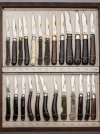
Will, is there a link to the catalog?LOT 653 from the auction catalogue drew my attention (you can click on each lot for enlargements and details) This comprised a salesman's display board with the Lockwood Bros. knives still in place and pattern No.s and prices inked in by hand. From the late c19th to early c20th, clearly the author Iain Flemming must have seen these as a child....one knife 8438 is stamped GOLD FINGERan all brass affair with EZ -Open cut out . These were a mere 29 shillings- for a dozen? (1.45 GBP in decimal money) whereas a 2 blade Ivory item commanded 59 shillings a dozen (2.95 GBP) Coco wood one of the cheaper options over Ebony, Horn or Stag.
Some of the Lockwood Bros. knives include the famous blade stamp of a Rhea, Ostrich like bird with 'Real Pampa Knife' introduced according to the notes, as a counter blast to then cheaper German knock-offs. The quality of the Stag is worth zooming in on, unbelievable popcorn to say the least! One of them 8121 1/2 has a very impressive small bolster and looks to be a Lamb Foot yet is stamped 'Etrrick' whereas the Ettrick type knives below it are not.
Yes, in my post 2659 click on the link , scroll through the catalogue (3 pages) lot 653 is I think on the second page, click open the lot so you can look at pictures zoom in etc, also shows he price achieved.Will, is there a link to the catalog?
Thanks RachelWow, that IS unusual, I love the small Lamby blade
Mine is much more pedestrian, but I've never been able to work out the maker. Some pics from about 15 years ago :
View attachment 2772756
View attachment 2772755
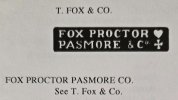
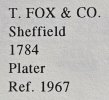

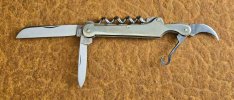
Many thanks for your research Neal, that's a fascinating insight. I bought that knife, for a few Pounds, a long time ago, struggled to find out anything about it, or even to read the tang stamp, and basically then forgot about it. That's a wonderful example by RodgersJack, that is a very interesting and quite old trademark stamp which peaked my interest. The reason you couldn't find any information on it is because that "Heart and Maltese Cross" mark is that of a plater, not a cutler.
It took a bit of digging to find it which is not listed in Tweedale's book since "T. Fox & Co." was not categorized as a cutlery company. Fox had deep roots dating back to 1784 and made it well into the 20th century.
The blade tang on your knife reads "George -------" ? and not T. Fox, but there was a George Kible listed as a primary in the company in 1911 which is about the right timeframe for that knife. Kible doesn't seem to match up quite right, but maybe?
Either way, that model was certainly made by another Sheffield cutlery company which contracted out to Fox to produce this nice example.
Enclosed are some pictures with information along with a catalog illustration from Lockwood which shows a knife pretty close to your model. Also enclosed is a Joseph Rodgers example of mine which is similar as well.
View attachment 2773821
View attachment 2773823
View attachment 2773828
View attachment 2773832

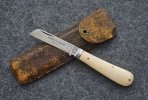
Hayden-Wright certainly did have a princely collection and I think all the considerable proceeds went to a US University or foundation concerned with antique weaponry?JPD1998, that's a nice post WWII Wostenholm model.
Will Power, David Hayden Wright did have an incredible collection which is now in the hands of many fortunate collectors from around the world.
Jack, glad to add a bit to that fine old knife and thanks for the thumbs up on my example.
Here is an older Joseph Rodgers Sheep Foot model with white bone handles.
View attachment 2775135






 A really good example of Golden Age craftsmanship all round.
A really good example of Golden Age craftsmanship all round. I think it's a valuable reference work as it shows a wealth of knife types, predominantly English and connected to this time-period. A rare chance to view groups of knives from a lost time, enthusiasts of fixed blades , Bowies etc will not be disappointed either.
I think it's a valuable reference work as it shows a wealth of knife types, predominantly English and connected to this time-period. A rare chance to view groups of knives from a lost time, enthusiasts of fixed blades , Bowies etc will not be disappointed either.